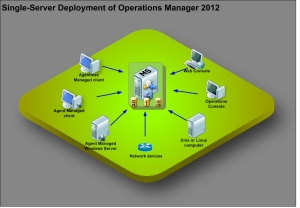Single-server management group installation
The single-server management group scenario combines all the management group roles that can coexist onto a single instance of the Windows Server 2008 R2 SP1 operating system running as a member server in an Active Directory domain. This instance can be on dedicated hardware or on a virtual computer. The Operations console can be deployed to computers other than the single server, and the web console is accessed via a browser.

Available Operations Manager Services in Single-Server Deployment
- The single-server management group configuration supports the following services:
- Monitoring and alerting
- Reporting (available in the Operations console but not in the web console)
- Audit collection
- Agentless exception management
- Data (accessed by using the web console and the Operations console)
Restrictions
The single-server management group configuration is the easiest to deploy, but there are limitations to its capabilities and therefore limitations to what it is commonly used for.
High Availability and Redundancy
The single server, single management group resides on a single set of hardware. This configuration supports only one instance of each server role and therefore cannot support agent failover between management servers.
Gateway Server
This configuration does not include the gateway server role. Because of this, all monitored devices must be in the same Active Directory domain as the management server or you must use certificates on both the managed computer and the management server to provide for mutual authentication.
For information about deploying single-server management group scenario, go to Single-Server Deployment of Operations Manager.
Distributed management group installation
The distributed management group installation will form the foundation of 99 percent of System Center 2012 – Operations Manager deployments. It allows for the distribution of features and services across multiple servers to allow for scalability and also provides availability. It can include all Operations Manager server roles and supports the monitoring of devices across trust boundaries through the use of the gateway server.
The following diagram presents one possible option for the distributed management group topology

For information about deploying distributed management group scenario, go to Distributed Deployment of Operations Manager
System Center 2012 – Operations Manager Cross Platform Visibility
Microsoft System Centre Operations Manager 2007 introduced Distributed Application Models and Synthetic Transactions as part of extending the visibility of monitoring solution. In the later version, SCOM 2007 R2, Microsoft enhanced the visibility by introducing Cross Platform Monitoring. The cross platform monitoring provided the ability to monitor non-Microsoft operating system such as HP-UX, AIX, Linux and Solaris.
The introduction of native network monitoring and .NET / J2EE Application monitoring support in SCOM 2012 provides the ability to capture all components within your networks that are part of providing services to the users.
Following diagram represents the Components, Applications and Operating System platforms monitored out of the box through system Centre 2012 – Operations Manager.

More about network monitoring capabilities:
SCOM 2012 includes significant new network monitoring capabilities that make it a much more comprehensive monitoring solution for network admins. Some basic features have been present in older versions, but SCOM 2012 expands on these capabilities.
Following features are Included in SCOM 2012 out of the box:
- Network device discovery, monitoring and reporting
- SNMP v3 support. Previous versions of SCOM supported SNMP v1 and v2.
- IPv4 and IPv6 support
- Port/interface monitoring which includes: Up/down monitoring, Traffic volume, Utilization, Dropped packet rate, Broadcast traffic stats etc..
- VLAN health monitoring (Auto discovery of all the VLANs)
- Overall connection health
- Hot Standby Router Protocol (HSRP) group health
- New visualization/dashboards which includes : Overall network health summary, The health of a device on the network, its interface-level statistics, its neighbors and connected windows servers monitored by SCOM etc..







